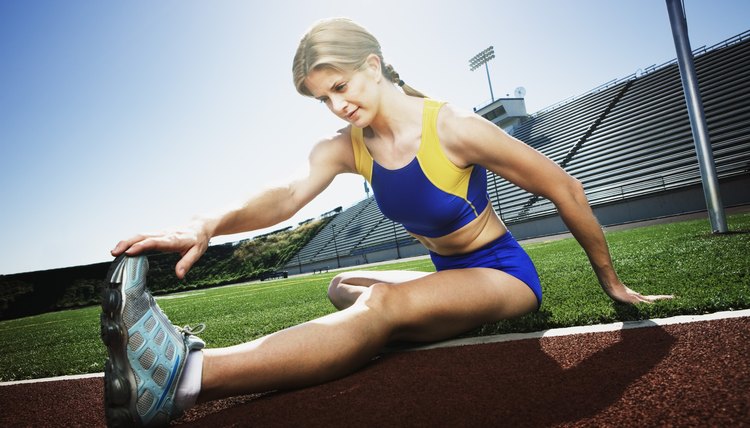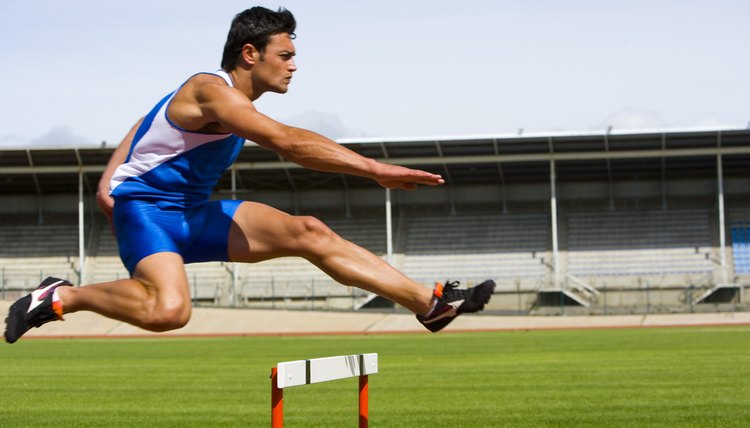How to Develop a Longer Running Stride

Running speed is determined by two basic variables: stride length and frequency. Developing a longer running stride will increase speed in both sprints and long-distance runs. Stride length is determined by the force applied to propel the body forward. In a running stride, the foot should contact the ground slightly in front of the hip and apply force. The other leg should be cycling forward into the next stride, and the runner will be airborne briefly between strides. By increasing the force application per stride, a runner can also increase stride length.
Flexibility for Stride Length

Maridav/iStock/Getty Images
Increasing stride length requires an increase in range of motion. It is important for any athlete to improve flexibility prior to attempting high-impact stride development exercises. Flexibility is crucial in the lower-body musculature, especially in the glutes, hip flexors, hamstrings and calves. Prior to running, an athlete should perform a dynamic warm-up that targets the lower body. A dynamic warm-up consists of movement-based stretches that increase the heart rate and blood flow to muscles. The maneuvers improve the elasticity and flexibility of a muscle more effectively than static stretching. Some recommended exercises would be ankle flips, high kicks, knee pulls and lunges.
Proper Technique for a Long Stride
To develop a longer running stride, proper running or sprinting technique is vital. By practicing running with proper form, correct motor patterns will be established that will lengthen the stride. Key points for proper running technique include running on the balls of the feet, raising the knees approximately waist high and applying force just in front of the hip. The torso should be locked and hips slightly tucked forward, and the arms should be at 90 degrees with the wrists relaxed. Form running should be practiced at least once a week to improve technique and minimize injury risk.
Improving Strength for Stride Development
Stride length is directly related to force application, or the amount of force generated by a foot strike on the ground. Increasing strength in the lower body is very important once you have a good degree of flexibility and correct running technique. According to Dr. Ralph Mann, a weight program for stride length will target the hamstring, quadriceps, gluteals and iliopsoas muscle groups. Exercises that would work for such a program include squats, cleans, bench step-ups, hamstring curls, and hip extensions. Consult with a coach or trainer for a specific strength program targeting these areas to improve stride length.
Plyometrics for Stride Development

Maridav/iStock/Getty Images
Plyometrics refer to a specific form of training to target and recruit fast-twitch muscle fibers. Once an athlete has good flexibility, correct technique and a solid base of strength, he can begin plyometric training to build stride length. A plyometric exercise for running focuses on a high-intensity, low-volume exercise that minimizes contact time with ground. Plyometric exercises include skipping, pogo jumps, high knees and bounds. Always perform a full dynamic warm-up and practice plyometrics in moderation. Once or twice a week for 10 to 15 minutes is sufficient for a plyometric workout to increase stride length. Consult a coach or specialist prior to beginning a plyometric program to ensure a safe and effective protocol.
References
- Cavagna GA, Saibene FP, Margaria R. MECHANICAL WORK IN RUNNING. J Appl Physiol. 1964;19:249-56. doi: 10.1152/jappl.1964.19.2.249
- CAVANAGH, P. R., & KRAM, R. (1989). Stride length in distance running. Medicine & Science in Sports & Exercise, 21(4), 467???479. doi:10.1249/00005768-198908000-00020
- De Ruiter, C. J., Verdijk, P. W. L., Werker, W., Zuidema, M. J., & de Haan, A. (2013). Stride frequency in relation to oxygen consumption in experienced and novice runners. European Journal of Sport Science, 14(3), 251–258. doi:10.1080/17461391.2013.783627
- HEIDERSCHEIT, B. C., CHUMANOV, E. S., MICHALSKI, M. P., WILLE, C. M., & RYAN, M. B. (2011). Effects of Step Rate Manipulation on Joint Mechanics during Running. Medicine & Science in Sports & Exercise, 43(2), 296–302. doi:10.1249/mss.0b013e3181ebedf4
- Salo AI, Bezodis IN, Batterham AM, Kerwin DG. Elite sprinting: are athletes individually step-frequency or step-length reliant?. Med Sci Sports Exerc. 2011;43(6):1055-62. doi: 10.1249/MSS.0b013e318201f6f8
- Schubert, A. G., Kempf, J., & Heiderscheit, B. C. (2014). Influence of stride frequency and length on running mechanics: a systematic review. Sports health, 6(3), 210–217. doi:10.1177/1941738113508544
- van Oeveren, B. T., de Ruiter, C. J., Beek, P. J., & van Dieën, J. H. (2017). Optimal stride frequencies in running at different speeds. PloS one, 12(10), e0184273. doi:10.1371/journal.pone.0184273
Writer Bio
Henry is a Philadelphia-based personal trainer and writer. He has trained a wide range of clients, from professional athletes to working professionals. Feel free to contact Henry with any questions regarding an article that he's written.
